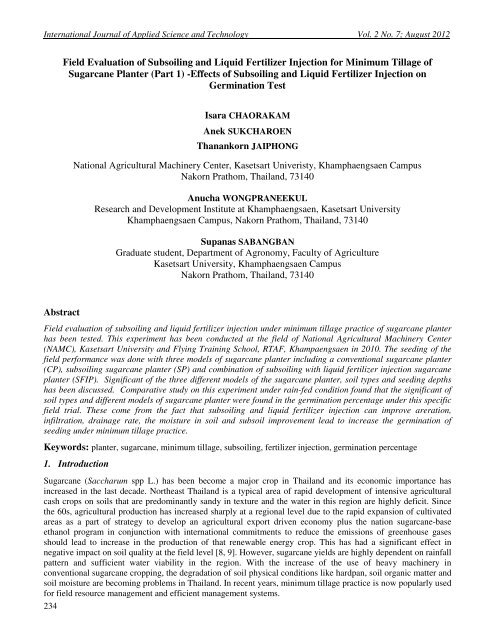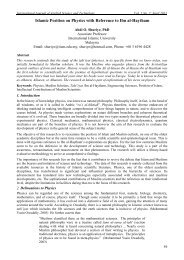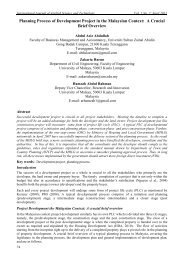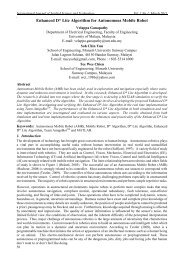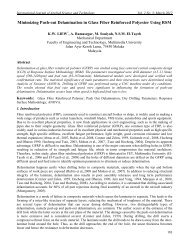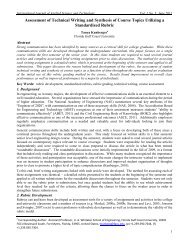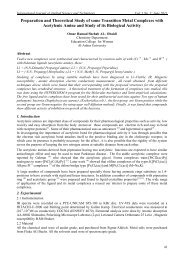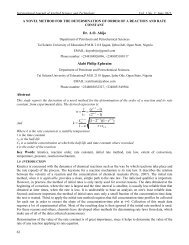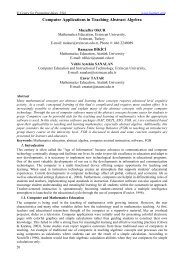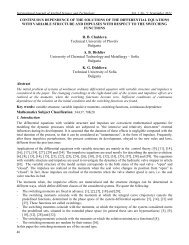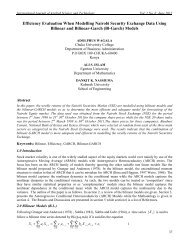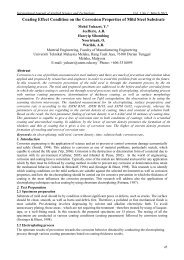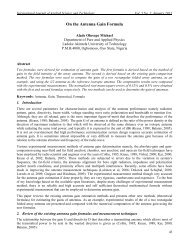Field Evaluation of Subsoiling and Liquid Fertilizer Injection for ...
Field Evaluation of Subsoiling and Liquid Fertilizer Injection for ...
Field Evaluation of Subsoiling and Liquid Fertilizer Injection for ...
You also want an ePaper? Increase the reach of your titles
YUMPU automatically turns print PDFs into web optimized ePapers that Google loves.
International Journal <strong>of</strong> Applied Science <strong>and</strong> Technology Vol. 2 No. 7; August 2012<br />
<strong>Field</strong> <strong>Evaluation</strong> <strong>of</strong> <strong>Subsoiling</strong> <strong>and</strong> <strong>Liquid</strong> <strong>Fertilizer</strong> <strong>Injection</strong> <strong>for</strong> Minimum Tillage <strong>of</strong><br />
Sugarcane Planter (Part 1) -Effects <strong>of</strong> <strong>Subsoiling</strong> <strong>and</strong> <strong>Liquid</strong> <strong>Fertilizer</strong> <strong>Injection</strong> on<br />
Germination Test<br />
Isara CHAORAKAM<br />
Anek SUKCHAROEN<br />
Thanankorn JAIPHONG<br />
National Agricultural Machinery Center, Kasetsart Univeristy, Khamphaengsaen Campus<br />
Nakorn Prathom, Thail<strong>and</strong>, 73140<br />
Anucha WONGPRANEEKUL<br />
Research <strong>and</strong> Development Institute at Khamphaengsaen, Kasetsart University<br />
Khamphaengsaen Campus, Nakorn Prathom, Thail<strong>and</strong>, 73140<br />
Supanas SABANGBAN<br />
Graduate student, Department <strong>of</strong> Agronomy, Faculty <strong>of</strong> Agriculture<br />
Kasetsart University, Khamphaengsaen Campus<br />
Nakorn Prathom, Thail<strong>and</strong>, 73140<br />
Abstract<br />
<strong>Field</strong> evaluation <strong>of</strong> subsoiling <strong>and</strong> liquid fertilizer injection under minimum tillage practice <strong>of</strong> sugarcane planter<br />
has been tested. This experiment has been conducted at the field <strong>of</strong> National Agricultural Machinery Center<br />
(NAMC), Kasetsart University <strong>and</strong> Flying Training School, RTAF, Khampaengsaen in 2010. The seeding <strong>of</strong> the<br />
field per<strong>for</strong>mance was done with three models <strong>of</strong> sugarcane planter including a conventional sugarcane planter<br />
(CP), subsoiling sugarcane planter (SP) <strong>and</strong> combination <strong>of</strong> subsoiling with liquid fertilizer injection sugarcane<br />
planter (SFIP). Significant <strong>of</strong> the three different models <strong>of</strong> the sugarcane planter, soil types <strong>and</strong> seeding depths<br />
has been discussed. Comparative study on this experiment under rain-fed condition found that the significant <strong>of</strong><br />
soil types <strong>and</strong> different models <strong>of</strong> sugarcane planter were found in the germination percentage under this specific<br />
field trial. These come from the fact that subsoiling <strong>and</strong> liquid fertilizer injection can improve areration,<br />
infiltration, drainage rate, the moisture in soil <strong>and</strong> subsoil improvement lead to increase the germination <strong>of</strong><br />
seeding under minimum tillage practice.<br />
Keywords: planter, sugarcane, minimum tillage, subsoiling, fertilizer injection, germination percentage<br />
1. Introduction<br />
Sugarcane (Saccharum spp L.) has been become a major crop in Thail<strong>and</strong> <strong>and</strong> its economic importance has<br />
increased in the last decade. Northeast Thail<strong>and</strong> is a typical area <strong>of</strong> rapid development <strong>of</strong> intensive agricultural<br />
cash crops on soils that are predominantly s<strong>and</strong>y in texture <strong>and</strong> the water in this region are highly deficit. Since<br />
the 60s, agricultural production has increased sharply at a regional level due to the rapid expansion <strong>of</strong> cultivated<br />
areas as a part <strong>of</strong> strategy to develop an agricultural export driven economy plus the nation sugarcane-base<br />
ethanol program in conjunction with international commitments to reduce the emissions <strong>of</strong> greenhouse gases<br />
should lead to increase in the production <strong>of</strong> that renewable energy crop. This has had a significant effect in<br />
negative impact on soil quality at the field level [8, 9]. However, sugarcane yields are highly dependent on rainfall<br />
pattern <strong>and</strong> sufficient water viability in the region. With the increase <strong>of</strong> the use <strong>of</strong> heavy machinery in<br />
conventional sugarcane cropping, the degradation <strong>of</strong> soil physical conditions like hardpan, soil organic matter <strong>and</strong><br />
soil moisture are becoming problems in Thail<strong>and</strong>. In recent years, minimum tillage practice is now popularly used<br />
<strong>for</strong> field resource management <strong>and</strong> efficient management systems.<br />
234
© Centre <strong>for</strong> Promoting Ideas, USA www.ijastnet.com<br />
The term <strong>of</strong> minimum tillage is defines as the specific tillage practices where minimum or no disturbance <strong>of</strong> the<br />
soil taking in place at the field <strong>and</strong> the slot was <strong>for</strong>med <strong>for</strong> successive <strong>of</strong> seeding operation. Also the remaining<br />
part <strong>of</strong> the field is left <strong>of</strong> an undisturbed <strong>and</strong> also some scattered residue around the field surface. Development <strong>of</strong><br />
the planter machine need some necessitate technological improvements that are pertinent to the dynamic <strong>of</strong> soilseed-implement<br />
interaction. The slot characteristics need to have a consideration effects on the stable plant<br />
growth including the soil texture, the drainage rate, infiltration, aeration <strong>and</strong> also the degree <strong>of</strong> soil compaction [1,<br />
2]. Several studies have been showed that soil compaction has negative impact on plant <strong>and</strong> root development [3,<br />
10]. The increasing <strong>of</strong> the minimum tillage practice, which can help to improve the environment <strong>of</strong> the soil,<br />
reduces the requirement <strong>of</strong> the labor <strong>and</strong> fuel consumption <strong>and</strong> less time in l<strong>and</strong> preparation.<br />
Accordingly, it is necessary to make the ef<strong>for</strong>ts to simplify the tillage sequence <strong>and</strong> also to reduce the number <strong>of</strong><br />
times in l<strong>and</strong> preparation <strong>of</strong> the machine, taking into account <strong>of</strong> the advantage <strong>of</strong> subsoiling treatment.<br />
Consequently, under these considerations, a new working mechanical attachment that enable carrying out <strong>of</strong><br />
subsoiling, liquid fertilizer injection <strong>and</strong> planting simultaneously, has been developed; subsequently, fuel<br />
consumption <strong>and</strong> effects on seeding germination <strong>of</strong> the crop were studied in comparison with conventional<br />
systems, in this research activity.<br />
2. Materials <strong>and</strong> methods<br />
2.1 <strong>Field</strong> preparation<br />
The in<strong>for</strong>mation on minimum tillage <strong>of</strong> sugarcane cultivation is scare in literature. Although the study was only<br />
carried out over 1 year, our experimental dataset might be useful underst<strong>and</strong>ing <strong>for</strong> the next following research<br />
study <strong>of</strong> sugarcane cropping system under rain-fed condition. Weed compete with seeding <strong>for</strong> nutrients, soil<br />
moisture etc. Using chopping or mowing machine equipment <strong>for</strong> proper field trial in minimum tillage practice <strong>for</strong><br />
sugarcane cultivation is the alternative way in this study. As a result, moisture conservation was kept as a<br />
criterion managed to keep it as a targets requirement <strong>of</strong> this practice.<br />
(a) Mowing or chopping implement<br />
(b) Three disc plow <strong>for</strong> conventional l<strong>and</strong> preparation<br />
Fig. 1 Implement in used<br />
235
International Journal <strong>of</strong> Applied Science <strong>and</strong> Technology Vol. 2 No. 7; August 2012<br />
2.2 Experimental tests <strong>and</strong> site description<br />
A cone penetrometer (Daiki Rika Kogyo Co., Ltd., Japan, Model DIK 5500) was used <strong>for</strong> measurement <strong>of</strong> soil<br />
hardness with a 30° cone apex angle <strong>and</strong> 78.57mm 2 base area at three places in each plot.<br />
Be<strong>for</strong>e testing, soil were sampled at the depth <strong>of</strong> 100mm by using a 50mmø soil core sampler <strong>and</strong> then brought to<br />
the laboratory <strong>for</strong> the measurements <strong>of</strong> soil moisture content <strong>and</strong> its distribution <strong>of</strong> each treatment. Then, soil<br />
samplers were dried at 110°C <strong>for</strong> 24h to determine the moisture content <strong>and</strong> the dry bulk density. The particle size<br />
distribution <strong>of</strong> the soil was analyzed by the pipette method using a kohn-type pipette analyzer. Accordingly, the<br />
laboratory results <strong>of</strong> the percentage finer found that the tested soils were found to consist <strong>of</strong> 13.73% clay, 31.76%<br />
silt, <strong>and</strong> 54.51% s<strong>and</strong> in the field <strong>of</strong> NAMC <strong>and</strong> 17.25% clay, 32.99 silt, <strong>and</strong> 49.76% s<strong>and</strong> in the field <strong>of</strong> RTAF<br />
respectively. There<strong>for</strong>e, the soil types were classified falling into s<strong>and</strong>y loam <strong>and</strong> loam respectively.<br />
The fields test were conducted at the research field <strong>of</strong> national Agricultural Machinery Center, Kasetsart<br />
University, Khampaengsaen Campus Nakorn Prathom, Thail<strong>and</strong> (latitude 14° 1ʹ 53.63ʺN, longitude 99° 58ʹ<br />
6.88ʺE) <strong>and</strong> Flying Training School, RTAF, Khampaengsaen, Nakorn Prathom, Thail<strong>and</strong> (latitude 14° 5ʹ 6.16ʺN,<br />
longitude 99° 55ʹ 53.74ʺE) from April 2010-May 2011.<br />
Summarized items <strong>of</strong> soil properties <strong>of</strong> the tested soils with different values <strong>of</strong> soil particle size distribution,<br />
organic matter <strong>and</strong> moisture content <strong>of</strong> the soil has been represented in Table 1.<br />
Table. 1 Summarized items related with the field measurements<br />
Item<br />
Tillage<br />
practice<br />
NAMC<br />
Minimum<br />
tillage<br />
practice<br />
Tillage<br />
practice<br />
RTAF<br />
S<strong>and</strong>; [%] 54.51 49.76<br />
Silt; [%] 31.76 32.99<br />
Clay; [%] 13.73 17.25<br />
Soil texture S<strong>and</strong>y Loam Loam<br />
OM [%] 0.91 1.37<br />
MC [% d.b.] 14.51 12.39<br />
Bulk density<br />
Minimum<br />
tillage<br />
practice<br />
[Mg/m 3 ]<br />
1-1.4 1.06-1.43<br />
CI [MPa] 1.4 1.7 1.4 1.75<br />
Seeding depth<br />
[mm]<br />
75, 100 75, 100<br />
2.3 Functional features <strong>of</strong> the developed sugarcane planter<br />
Three different models <strong>of</strong> sugarcane planter composed <strong>of</strong> a conventional sugarcane planter (CP), subsoiling<br />
sugarcane planter (SP) <strong>and</strong> subsoiling with fertilizer injection sugarcane planter (SFIP) have been tested to<br />
evaluate the per<strong>for</strong>mance in this field experiment. The new working attachment was developed through the<br />
modification <strong>of</strong> the commercial sugarcane planter attachment as a base. The structure <strong>of</strong> the newly development is<br />
illustrated in Fig. 2(a). The subsoiling implement has been attached in front <strong>of</strong> the commercial sugarcane planter.<br />
The working depth <strong>of</strong> the subsoiling has been set at 300mm from the ground surface. The 25mmø with 300mm <strong>of</strong><br />
length <strong>of</strong> the stainless tube has been attached at the rear side <strong>of</strong> the subsoiling <strong>for</strong> liquid fertilizer injection. The<br />
tank <strong>of</strong> 1000 liters <strong>of</strong> liquid fertilizer has been taking placed on the ro<strong>of</strong> <strong>of</strong> the tractor under the supportive<br />
structure as shown in Fig. 2(b). This experiment has been blended the fertilizer <strong>of</strong> 0-52-34 <strong>for</strong>mula <strong>of</strong> 1kg with<br />
200L <strong>of</strong> water <strong>for</strong> liquid fertilizer. This fertilizer aimed <strong>for</strong> germination improvement, nutrient accumulation <strong>and</strong><br />
stable growth <strong>of</strong> the crop. The submersible pump has been installed inside the tank with the setting <strong>of</strong> the capacity<br />
<strong>of</strong> the liquid fertilizer at 2l/m. Designed <strong>of</strong> subsoiling has been aimed toward low soil disturbance to minimize<br />
soil moisture loss from the slot, aeration, infiltration <strong>and</strong> subsoil improvement <strong>for</strong> better seedbed preparation after<br />
the seeding process. The slot making in which desirable seedbed condition could be created to meet the<br />
requirement <strong>of</strong> better seedbed preparation lead to stable plant growth.<br />
236
© Centre <strong>for</strong> Promoting Ideas, USA www.ijastnet.com<br />
(a) <strong>Subsoiling</strong> <strong>and</strong> liquid <strong>Fertilizer</strong> Tube<br />
2.4 Experimental design<br />
(b) Supportive fertilizer tanks<br />
Fig. 2 Developed sugarcane planter<br />
Three different type <strong>of</strong> sugarcane planters were evaluated with the seeding per<strong>for</strong>mance tests regarding with fuel<br />
consumption, germination percentage. The field experiment at both sites has been subdivided into 6 plots. Each<br />
plot was 15×50m 2 to per<strong>for</strong>m in this specific field trial. The reported data <strong>of</strong> fuel consumption <strong>of</strong> each tillage<br />
sequence can be done using the re-filled method. The target <strong>of</strong> the traveling speed <strong>of</strong> the tractor was set at 2.5m/s<br />
with 75 <strong>and</strong> 100mm deep <strong>of</strong> the working depth. A 2 × 2 × 3 factorial experiment in completely r<strong>and</strong>omized design<br />
was conducted <strong>for</strong> each operational trial. Each treatment was replicated five times each <strong>and</strong> the mean values <strong>of</strong> the<br />
treatments were analyzed using Least Significant Difference (LSD) method. A statistical analysis was per<strong>for</strong>med<br />
using the SAS statistical s<strong>of</strong>tware. The results <strong>of</strong> these analyses on seeding per<strong>for</strong>mance tests were satisfactorily<br />
expected to assess the capability <strong>of</strong> the machines tested.<br />
(1) Effect <strong>of</strong> subsoiling <strong>and</strong> liquid fertilizer injection <strong>of</strong> developed sugarcane planter on germination percentage<br />
In many coarse textured soils, such as an Arenic Acrisol soil texture in Northeast Thail<strong>and</strong>, limited root<br />
development <strong>and</strong> biomass production are attributed to adverse physical condition in the subsoil <strong>and</strong> subsoil<br />
degradation is increasingly being recognized as a scares problem to achieving sustainable sugarcane crop<br />
production on the range <strong>of</strong> soil type [4, 5, 6, 11]. Rehabilitation technique using subsoil has been aiming to<br />
warded low subsoil loosening resulted in an increased root length below plowing depth in irrigated plot <strong>and</strong> up to<br />
13% <strong>of</strong> total water uptake was supplied by capillary rise to the root zone [7]. Thus, to maintain agricultural<br />
productions in marginal agro-eco-zones are donated by very poor farmers, subsoil rehabilitation techniques that<br />
are efficient <strong>and</strong> low cost are required. The effect <strong>of</strong> subsoiling <strong>and</strong> liquid fertilizer injection <strong>of</strong> the developed<br />
sugarcane planter has been observed at 30DAP. Be<strong>for</strong>e substantial tests, two rows <strong>of</strong> the boarder side <strong>and</strong> 5<br />
meters apart from each hedge <strong>of</strong> each subdivided plot has been omitted to prevent the edge effects. The five<br />
remaining rows with 5m <strong>of</strong> length <strong>of</strong> each inside <strong>of</strong> the subdivided plots have been selected <strong>for</strong> this experiment.<br />
Then, taking into account <strong>of</strong> the average germination percentage <strong>of</strong> each treatment <strong>of</strong> the selected sub-plot in the<br />
inter-rows <strong>of</strong> the seedling can be done. The un-germinated seedling has been observed in each selected rows by<br />
taking the vacant in places. <strong>Field</strong> observations <strong>of</strong> the germination <strong>of</strong> the seedling after machine operation at alls<br />
treatment were comparatively discussed in conjunction with the developed sugarcane planter.<br />
237
International Journal <strong>of</strong> Applied Science <strong>and</strong> Technology Vol. 2 No. 7; August 2012<br />
3. Results <strong>and</strong> discussion<br />
Three different types <strong>of</strong> sugarcane planter were comparatively studied in relation to germination percentage in the<br />
six subdivided plots at two locations. Consequently, average fuel consumption in each activity <strong>of</strong> l<strong>and</strong> preparation<br />
at both sites had been measured. Germination percentage was mainly use to confirm its contribution towards the<br />
improvement <strong>of</strong> the machine <strong>for</strong> the next research study.<br />
(a) Chopped arable weed on the field<br />
(b) Mechanical behavior on field tested<br />
Fig. 3 Represented <strong>of</strong> covered residue in the field <strong>and</strong> onsite mechanical action<br />
Table. 2 Fuel consumption <strong>of</strong> the sugarcane cultivation system<br />
<strong>Field</strong> condition<br />
Method <strong>of</strong> field<br />
preparation<br />
Fuel<br />
consumption<br />
Total,<br />
L/ha<br />
Minimum tillage<br />
practice, SP<br />
Mown implement<br />
<strong>Subsoiling</strong> planter<br />
5L/ha<br />
13.51L/ha<br />
18.51<br />
Minimum tillage<br />
practice, SFIP<br />
Mown implement<br />
<strong>Subsoiling</strong> with liquid<br />
fertilizer injection<br />
5L/ha<br />
13.50L/ha<br />
18.50<br />
Three disc plow<br />
17.63L/ha<br />
Conventional<br />
practice<br />
Three disc plow<br />
Seven disc plow<br />
17.63L/ha<br />
24.94L/ha<br />
73.51<br />
Conventional sugarcane<br />
planter<br />
13.31L/ha<br />
Table 2 has been represented about the breakdown dataset <strong>of</strong> two different methods <strong>of</strong> sugarcane cultivation.<br />
Minimum tillage practice has been represented a highlight <strong>of</strong> saving fuel. Similarly <strong>of</strong> breakdown data has been<br />
showed among three different models <strong>of</strong> sugarcane planter in the table.<br />
238
© Centre <strong>for</strong> Promoting Ideas, USA www.ijastnet.com<br />
Mown or chopping implement showed minimum fuel consumption <strong>for</strong> minimum tillage practice whereas three<br />
disc plow <strong>and</strong> seven disc plow showed the consumption <strong>of</strong> the fuel at 17.63 <strong>and</strong> 24.94L/ha respectively <strong>and</strong> the<br />
amount <strong>of</strong> 55L/ha <strong>of</strong> fuel can be save in this both field trial. This result could be guaranteed that minimum tillage<br />
practice not only conserved the soil <strong>and</strong> moisture but also showed something specific in saving fuel in l<strong>and</strong><br />
preparation.<br />
(1) Effect <strong>of</strong> subsoiling <strong>and</strong> liquid fertilizer injection <strong>of</strong> sugarcane planter on germination percentage<br />
The germination <strong>of</strong> the sugarcane seeding <strong>of</strong> each field trial has been done at 30DAP. <strong>Subsoiling</strong> <strong>and</strong> liquid<br />
fertilizer injection showed satisfactorily observed as represented in Fig. 4.<br />
(a) CP at 75 <strong>and</strong> 100mm <strong>of</strong> seeding depth<br />
(b) SP at 75 <strong>and</strong> 100mm <strong>of</strong> seeding depth<br />
(C) SFIP at 75 <strong>and</strong> 100mm <strong>of</strong> seeding depth<br />
Fig. 4 Represented <strong>of</strong> germinated seedling at 30DAP<br />
Figs. 5-6 showed similar trend <strong>of</strong> the germination percentage between both locations with different <strong>of</strong> seeding<br />
depths (75, 100mm). In general, with an increasing <strong>of</strong> seeding depth, it could be found that SP showed significant<br />
results compared with CP in both locations. However, with an increasing <strong>of</strong> seeding depth, germination<br />
percentage has been decreasing except under SIFP condition. This come from the fact that the moisture in the<br />
liquid fertilizer could enhanced the germination <strong>of</strong> the seeding. The increasing rates <strong>of</strong> the germination<br />
percentage fluctuate irregularly because <strong>of</strong> the effect <strong>of</strong> soil surface <strong>and</strong> the pertinent <strong>of</strong> different <strong>of</strong> soil types.<br />
239
International Journal <strong>of</strong> Applied Science <strong>and</strong> Technology Vol. 2 No. 7; August 2012<br />
For the case <strong>of</strong> CP, minimum germination percentage obviously observed under this practice. Under this tillage<br />
practice, pore space in soil texture has been per<strong>for</strong>med by using intensive tillage implements. Moisture regime<br />
under aggregated tillage zone area has been loosen that induced lower germination percentage <strong>of</strong> these practices.<br />
89<br />
88<br />
87<br />
86<br />
85<br />
Germination; %<br />
88.34<br />
87.78 87.76 87.91<br />
86.93 86.76<br />
SP+75 SP+100 SFIP+75 SFIP+100 CP+75 CP+100<br />
Fig. 5 Germination percentage at s<strong>and</strong>y loam soil tested field<br />
88<br />
86<br />
84<br />
82<br />
80<br />
Germination; %<br />
87.33<br />
86.56<br />
85.65<br />
84.36<br />
84.18 83.74<br />
SP+75 SP+100 SFIP+75 SFIP+100 CP+75 CP+100<br />
Fig. 6 Germination percentage at loamy soil tested field<br />
Table. 3 ANOVA results related to germination percentage<br />
Degree-<br />
<strong>of</strong>-<br />
Freedom<br />
Sum <strong>of</strong><br />
Squares<br />
Mean<br />
Square<br />
Treatment 11 138.90 12.63 3.04 *<br />
A (Soil type) 1 77.73 77.73 18.71 *<br />
B (Planter type) 2 45.48 22.74 5.47 *<br />
C (Depth) 1 0.22 0.22 0.05 ns<br />
A×B 2 9.04 4.52 1.09 ns<br />
A×C 1 0.60 0.60 0.14 ns<br />
B×C 2 4.22 2.11 0.51 ns<br />
A×B×C 2 1.62 0.81 0.20 ns<br />
Error 48 199.44 4.16<br />
Total 59 338.34<br />
* significant at P=0.05<br />
Furthermore, variation analysis has been used to verify the practical effectiveness, as shown in Table 3. The<br />
results from ANOVA indicated that the major factors <strong>of</strong> soil type <strong>and</strong> three different models <strong>of</strong> sugarcane planter<br />
were falling to be found significantly different at P=0.05. The statistical analysis showed no significant difference<br />
in the interaction parameters <strong>and</strong> seeding depth, thus implying an engineering concept <strong>for</strong> improving the major<br />
design experimental research variables. In fact the modification <strong>of</strong> the prototype <strong>of</strong> subsoiling sugarcane planter<br />
had been proposed as an ideal model <strong>for</strong> minimum tillage <strong>of</strong> sugarcane planter. But the designs <strong>of</strong> the machine<br />
need some adjustment <strong>of</strong> the implement <strong>for</strong> the success <strong>of</strong> the planting mechanism.<br />
A comparison based on mean values using LSD method represented in Table 4. From the analysis <strong>of</strong> this<br />
experiment, it could be emphasized that subsoiling can per<strong>for</strong>m to induce the germination percentage after the<br />
operation <strong>of</strong> SP <strong>and</strong> SFIP under the entire combination.<br />
240<br />
F
© Centre <strong>for</strong> Promoting Ideas, USA www.ijastnet.com<br />
These results came from the fact that subsoiling device can aggregated seeding zone be<strong>for</strong>e seeding operation <strong>for</strong><br />
a better seedbed preparation in terms <strong>of</strong> aeration, infiltration, drainage rate <strong>and</strong> subsoil improvement especially<br />
under drought condition. Highest values <strong>of</strong> germination percentage data could be observed in the results <strong>of</strong> SFIP.<br />
This came from the fact that the moisture in liquid fertilizer has been improved the germination <strong>of</strong> the seeding in<br />
this experiment in alls entire combination. This result could be used to conclude that the configuration <strong>of</strong> SFIP<br />
representation was satisfactory done under the entire combination.<br />
Table. 4 Comparison between mean values <strong>of</strong> germination percentage<br />
Soil type Depth<br />
Mean value<br />
CP SP SFIP<br />
S<strong>and</strong>y loam<br />
75 86.53 a-c 87.78 ab 87.9 ab<br />
100 86.76 a-d 87.76 ab 88.34 a<br />
Loam<br />
75 84.18 de 85.65 b-e 86.56 a-d<br />
100 83.74 e 84.36 c-e 87.33 ab<br />
LSD 0.05 2.59<br />
CV. (%) 2.36<br />
Note: Means followed by the different superscript in the same row indicate significant difference between the<br />
mean values at P=0.05.<br />
Means followed by the different superscript in the same column indicate significant difference between the mean<br />
values at P=0.05.<br />
In the case <strong>of</strong> CP, unsatisfactory results in terms <strong>of</strong> germination percentage could be observed in both types <strong>of</strong> the<br />
tested soil. The moisture in soil has been loosen from the aggregated seeding zone area after tillage practice.<br />
For the case <strong>of</strong> SP, improvement <strong>of</strong> the germination percentage results could be observed after the seeding trial<br />
due partly to the advantageous <strong>of</strong> minimum tillage practice <strong>and</strong> subsoil improvement compared with CP.<br />
4. Conclusions<br />
This research has been conducted to clarify the per<strong>for</strong>mance test <strong>of</strong> subsoiling <strong>and</strong> liquid fertilizer injection <strong>of</strong><br />
minimum tillage <strong>of</strong> sugarcane planter by taking into account <strong>of</strong> the advantage <strong>of</strong> subsoiling treatment, fuel<br />
consumption <strong>and</strong> effects on seeding germination <strong>of</strong> the sugarcane crop had been discussed extensively based on<br />
the field test. Selected finding conclusions can be drawn as follows.<br />
(1) Minimum tillage practice showed the highlight benefit <strong>of</strong> saving fuel consumption in this experiment.<br />
(2) <strong>Subsoiling</strong> sugarcane planter could per<strong>for</strong>m to improve the germination percentage compared with<br />
conventional sugarcane planter. This come from the fact that moisture conservation in the soil, aeration,<br />
infiltration <strong>and</strong> the drainage rate could be created <strong>for</strong> better seed-soil contact whereas conventional<br />
sugarcane planter showed unsatisfactory done in this experiment. Loosing moisture in the soil after<br />
intensive tillage practice showed the disadvantage <strong>of</strong> the germination percentage.<br />
(3) <strong>Subsoiling</strong> in conjunction with liquid fertilizer injection sugarcane planter was confirmed to be effective<br />
regarding in germination percentage under entire combination. This machine demonstrated practical<br />
significant <strong>and</strong> recommendable per<strong>for</strong>mance <strong>of</strong> minimum tillage sugarcane planter in which desirable<br />
seedbed preparation could be created to meet the requirements <strong>of</strong> stable plant growth.<br />
(4) <strong>Subsoiling</strong> device proved in practice applicable regarding soil-seed-implement phenomenon. Without a<br />
subsoiling device, seedbed preparation could not be done that lead to unstable circumstance <strong>of</strong> the<br />
germination <strong>of</strong> the seeding. In addition, modification <strong>of</strong> the design criteria in regarding the relative setting<br />
position <strong>of</strong> this device was found to improve the field per<strong>for</strong>mance even with an uncultivated soil pr<strong>of</strong>ile.<br />
(5) Under this field experimental trial, germination percentage tends to depend on the pertinent <strong>of</strong> the soil<br />
properties <strong>and</strong> the different models <strong>of</strong> sugarcane planter.<br />
241
International Journal <strong>of</strong> Applied Science <strong>and</strong> Technology Vol. 2 No. 7; August 2012<br />
Acknowledgments<br />
The author indebted to express their gratitude to the staff members <strong>of</strong> the National Agricultural Machinery Center,<br />
Kasetsart University, <strong>for</strong> fabricating the implements <strong>and</strong> conducting the field per<strong>for</strong>mance tests <strong>and</strong> to Kasetsart<br />
University, Research <strong>and</strong> Development Institute <strong>for</strong> granted the valuable cooperation in providing the research<br />
fund <strong>of</strong> our field investigation.<br />
References<br />
Chaorakam, I., KOIKE, M., TAKIGAWA, T., YODA, A., HASEGAWA, H., BAHALAYODHIN, B., 2007.<br />
<strong>Field</strong> evaluation <strong>of</strong> slot openers <strong>for</strong> minimum tillage (part 1)-Effects <strong>of</strong> Rice Crop Residue o Drill<br />
Per<strong>for</strong>mance-. JSAM, 69 (6), 65-74.<br />
Chaorakam, I., KOIKE, M., TAKIGAWA, T., YODA, A., HASEGAWA, H., BAHALAYODHIN, B., 2007.<br />
<strong>Field</strong> evaluation <strong>of</strong> slot openers <strong>for</strong> minimum tillage (part 2)-Effects <strong>of</strong> Residue H<strong>and</strong>ling on Drill<br />
Per<strong>for</strong>mance-. JSAM, 69 (6), 75-83.<br />
Coelho, M.B., Mateos, L., Villaobos, F.J., 2000. Influence <strong>of</strong> a compacted loam subsoil layer on growth <strong>and</strong> yield<br />
<strong>of</strong> irrigated cotton in Southern Spain. Soil & Tillage Research, 57 (3), 129-142.<br />
Hartmann, C., Poss, R., Noble, D.A., Jongskul, A., Bourdon, E., Brunet, D., Lesturgez, G., 2008. Subsoil<br />
improvement in a tropical coarse textured soil: Effect <strong>of</strong> deep-ripping <strong>and</strong> slotting. Soil & Tillage Res, 99,<br />
245-253.<br />
Horn, R., 2000. Introductory remarks. In: Horn, R., van den Akker, J.J., Arvidson, J. (Eds.), Subsoil Compaction:<br />
Distribution, Processes <strong>and</strong> Consequences, Advances in Geoecology, 33, 32-43.<br />
Jayawardane, N.S., Stewart, B.A., 1995. Preface. In: Jayawardane, N.S., Stewart, B.A. (Eds.), Subsoil<br />
management Techniques, Advances in Soil Science, P. 244.<br />
Parker, C.J., Carr, M.K.V., Jarvis, N.J., Evan, M.T.B., Lee, V.H., 1989. Effects <strong>of</strong> subsoil loosening <strong>and</strong> irrigation<br />
on soil physical properties, root distribution <strong>and</strong> water uptake <strong>of</strong> potatoes (Solanum tuberosum). Soil &<br />
Tillage Research, 13, 267-285.<br />
Poss, R., Brunet, D., Thammakhet, P., Wacharasint, S., 1999. Soil acidification <strong>and</strong> potassium leaching in<br />
northeast Thail<strong>and</strong>. In: Proceedings <strong>of</strong> Second International Conference on L<strong>and</strong> Degradation, Khon<br />
Kaen, Thail<strong>and</strong>, pp. 25-29.<br />
Sukchan, S., Wichaidit, P., Pramojanee, P., Ota, T., Kohyama, K., Wada, H., 1999. Virgin soils <strong>and</strong> their<br />
degradation b agricultural practices in northeast Thail<strong>and</strong>. In: Proceedings <strong>of</strong> Second International<br />
Conference on L<strong>and</strong> Degradation, Khon Kaen, Thail<strong>and</strong>, pp. 25-29.<br />
Tsuji, H., Yamamoto, H., Matsuo, K., Usuki, K., 2006. The effects <strong>of</strong> long term conservation tillage, crop<br />
residues <strong>and</strong> P fertilizer on soil condition <strong>and</strong> responses <strong>of</strong> summer <strong>and</strong> winter crops on an Andosol in<br />
Japan. Soil & Tillage Research, 89 (2), 167-176<br />
Van den Akker, J.H., Arvidsson, J., Horn, R., 2003. Introduction to the special issue on experiences with the<br />
impact <strong>and</strong> prevention <strong>of</strong> subsoil compaction in the European Union. Soil & Tillage Research, 73 (1-2),<br />
1-8.<br />
242


